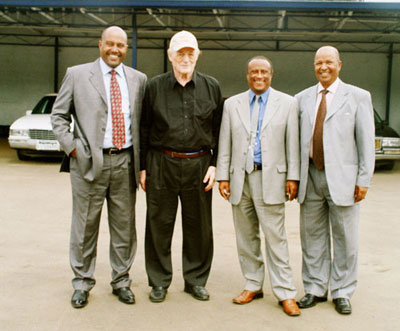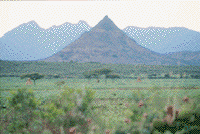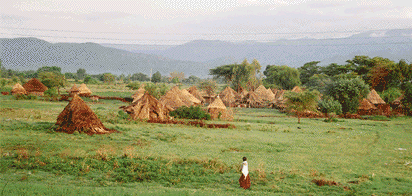|
|
|
|
|
|
|

|
Under Construction. More photos
and captions to come.
|
|
|
|
|
|
|
|
|
|
|
|
|
|
|
|
|
|
|
|
|
|
|
|
|
|
|
|
|
|
|
|
|
|
The finest fleet in Ethiopia.
We're ready to meet your needs for
any occasion from tours to conventions - and
more!

This page is
under construction. More to come.
Web site:
http://www.rainbowtravelplc.com/
E-Mail:
rainbowtours@ethionet.et
Tel : (251)-1-513755 . Fax :
(251)-1-515244
Enquuiries from
North America
E-mail airhwy@dowco.com

Africa Travel Magazine Editor with
team at Rainbow main office, Meskal Square, Addis
Ababa
|
ETHIOPIA TOURISM
INFORMATION
 Ethiopia
lies between the Equator and the Tropic of Capricorn. Its
area is 1,112,000 square Kilometers. Most parts of it are
elevated plateau rising from 2100 - 4400 meters. It is
divided into climate regions marked as Depression" which at
some points descends more than 90 meters below sea level.
Majestic mountains, imposing peaks, alluring and glamorous
gorges, ravishing tablelands, verdant pasturelands,
luxuriant tropical regions and the magnificent Rift Valley
are some of its physical formations. Ethiopia
lies between the Equator and the Tropic of Capricorn. Its
area is 1,112,000 square Kilometers. Most parts of it are
elevated plateau rising from 2100 - 4400 meters. It is
divided into climate regions marked as Depression" which at
some points descends more than 90 meters below sea level.
Majestic mountains, imposing peaks, alluring and glamorous
gorges, ravishing tablelands, verdant pasturelands,
luxuriant tropical regions and the magnificent Rift Valley
are some of its physical formations.
Splendid
landscapes sparsely wooded semi-desert tracts, tremendous
and unfamiliar physical relief and the infrequent wilderness
are some of the captivating, astonishing and outlandish
attractions that Ethiopia offers. As a land of great
physical contrast, its different territories are scenic and
awe-inspiring. The innumerable, magnificent crater lakes
characterized by their aquatic life, the alarming abysses,
the interweaving rivers, the enticing and graceful
waterfalls, the extraordinary Savannah, the unusual wild
domains and the uncommon natural phenomena in some parts of
this bounteous country are mystery-shrouded and
bizarre.
 Fascinating
as the Ethiopian history might be, even more so is its less
known pre-history. The discovery in Ethiopia in 1974 of a
3.3 million year fossilized skeleton of a distinct human
being has confirmed the long-standing assumption that
mankind originated in Africa (Ethiopia). It has also proved
since 1994 that Ethiopia is the origin of man's earliest
ancestry Ardipithecus Ramidus dating back to 4.4 million
years. Scientists have confirmed that the skeleton was the
remains of a woman whom they, somewhat romantically,
christened as Lucy. Fascinating
as the Ethiopian history might be, even more so is its less
known pre-history. The discovery in Ethiopia in 1974 of a
3.3 million year fossilized skeleton of a distinct human
being has confirmed the long-standing assumption that
mankind originated in Africa (Ethiopia). It has also proved
since 1994 that Ethiopia is the origin of man's earliest
ancestry Ardipithecus Ramidus dating back to 4.4 million
years. Scientists have confirmed that the skeleton was the
remains of a woman whom they, somewhat romantically,
christened as Lucy.
The cradle
of mankind with a recorded history of 3000 years! Mosaic of
unique cultures and home of the world's rarest animal and
bird life. The history of Ethiopia, as the story of the
interaction of diverse groups on one side and their
collective response to an external challenge on the other
has fascinated generations of scholars. A prominent Italian
scholar, Conti Rossini, described Ethiopia as museo dei
popoli, the museum of peoples or, as we say nowadays, "a
land of nations and nationalities. More to come, including
tour itineraries.
|

 ...
...



 Ethiopia
lies between the Equator and the Tropic of Capricorn. Its
area is 1,112,000 square Kilometers. Most parts of it are
elevated plateau rising from 2100 - 4400 meters. It is
divided into climate regions marked as Depression" which at
some points descends more than 90 meters below sea level.
Majestic mountains, imposing peaks, alluring and glamorous
gorges, ravishing tablelands, verdant pasturelands,
luxuriant tropical regions and the magnificent Rift Valley
are some of its physical formations.
Ethiopia
lies between the Equator and the Tropic of Capricorn. Its
area is 1,112,000 square Kilometers. Most parts of it are
elevated plateau rising from 2100 - 4400 meters. It is
divided into climate regions marked as Depression" which at
some points descends more than 90 meters below sea level.
Majestic mountains, imposing peaks, alluring and glamorous
gorges, ravishing tablelands, verdant pasturelands,
luxuriant tropical regions and the magnificent Rift Valley
are some of its physical formations. Fascinating
as the Ethiopian history might be, even more so is its less
known pre-history. The discovery in Ethiopia in 1974 of a
3.3 million year fossilized skeleton of a distinct human
being has confirmed the long-standing assumption that
mankind originated in Africa (Ethiopia). It has also proved
since 1994 that Ethiopia is the origin of man's earliest
ancestry Ardipithecus Ramidus dating back to 4.4 million
years. Scientists have confirmed that the skeleton was the
remains of a woman whom they, somewhat romantically,
christened as Lucy.
Fascinating
as the Ethiopian history might be, even more so is its less
known pre-history. The discovery in Ethiopia in 1974 of a
3.3 million year fossilized skeleton of a distinct human
being has confirmed the long-standing assumption that
mankind originated in Africa (Ethiopia). It has also proved
since 1994 that Ethiopia is the origin of man's earliest
ancestry Ardipithecus Ramidus dating back to 4.4 million
years. Scientists have confirmed that the skeleton was the
remains of a woman whom they, somewhat romantically,
christened as Lucy.